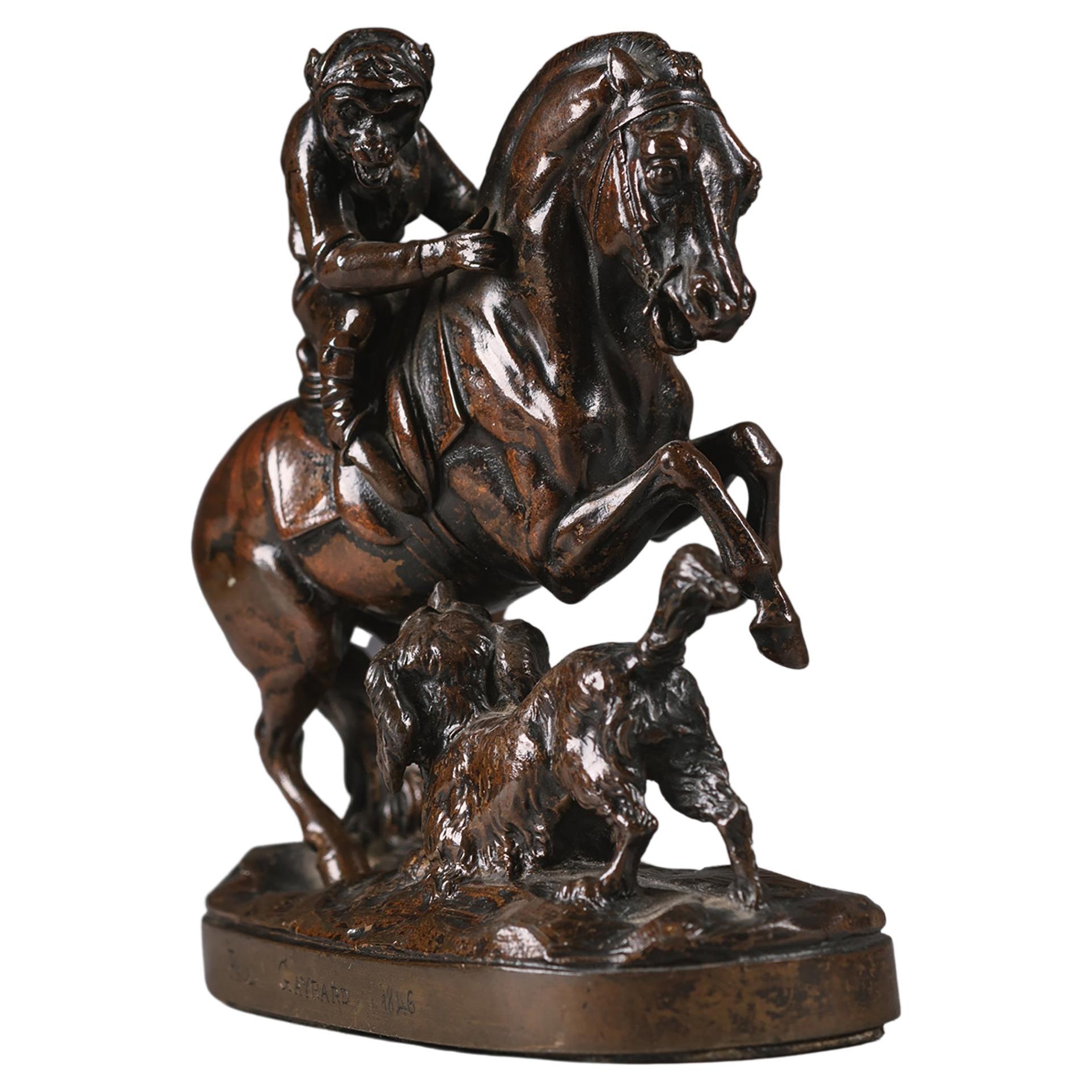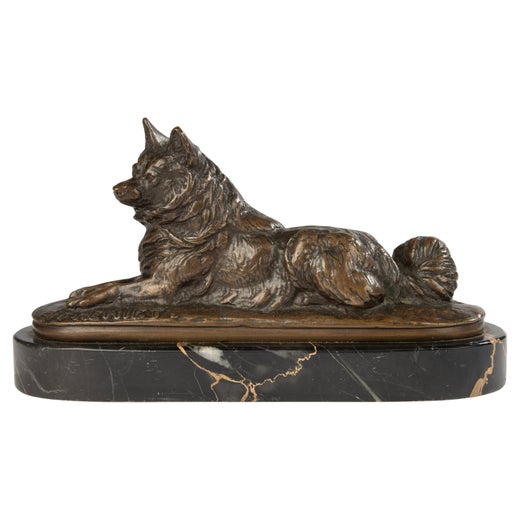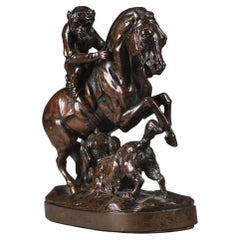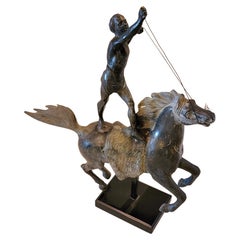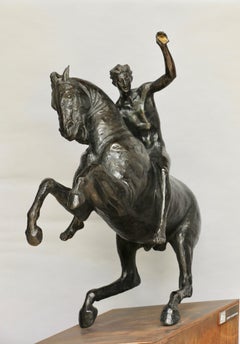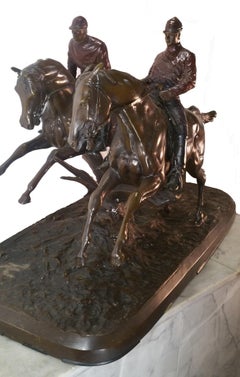Items Similar to Roman driver on his chariot
Want more images or videos?
Request additional images or videos from the seller
1 of 17
Emmanuel FremietRoman driver on his chariotcirca 1880
circa 1880
$7,827.21
£5,791.16
€6,500
CA$10,822.51
A$11,881.77
CHF 6,198.74
MX$143,785.95
NOK 77,691.64
SEK 73,205.95
DKK 49,491.18
About the Item
Roman driver on his chariot
by Emmanuel Fremiet (1824-1910)
Bronze group with its original nuanced green patina
signed on the base " E. Fremiet "
cast by More
France
circa 1880
height 43 cm
length 38 cm
depth 20 cm
Biography :
Emmanuel Fremiet (1824-1910) was the nephew and pupil of sculptor François Rude. Alongside his monumental works commissioned by the state, he was recognized as an excellent realistic animal sculptor. Emmanuel Fremiet devoted mainly to equestrian statues. He started as a scientific lithographer (osteology) and worked in the studio of painters from the morgue. In 1843 he sent to the Salon a "Gazelle" study preluding a prolific output. His "wounded Bear" and "injured Dog" acquired by the State for the Musée du Luxembourg in Paris in 1850. During the 1850s, Fremiet produced works on the theme of Napoleon III. He exposed bronzes representing bassets of Napoleon III, "Ravageot and Ravagode" at the Salon of 1853. From 1855 to 1859, he performed a series of military subject statuettes for the emperor. He realized the Napoleon Monument in 1868 and the one of Louis of Orleans in 1869 (Château de Pierrefonds). In 1874, Emmanuel Fremiet designed the first equestrian monument of Joan of Arc, erected on the Pyramids square in Paris, replaced with another version in 1900. During this period, he also performed "Pan and cubs" (Paris, Musée d'Orsay).
At the end of the nineteenth century, Fremiet was inspired by a new theme : the confrontation between man and beast. The news reported by the newspaper The Times that in 1880, in a Gabonese village, a bewildered and angry gorilla allegedly abducted and molested a woman, after having destroyed shacks. Moreover, the stories of explorers like Alfred Russel Wallace made articles and engravings for the newspapers, illustrating the attack of a Malaysian tracker by an orangutan. This theme inspired Fremiet several major works. "The Gorilla kidnapping a black woman" was initially refused by the jury of the Salon of 1859 and then presented behind a curtain. Another version received a medal of honor at the Salon of the Society of French Artists in 1887. This work, famous in his time, however rose a scandal because of it subject : it represented a gorilla kidnapping a naked woman, allegedly with a intent to rape her, what excited public curiosity. In the same vein, and even more remarkable was the "Orangutan strangling a wild Borneo" (1895), commissioned by the National Museum of Natural History in Paris, inspired by the stories of Wallace reported with many exaggerations by The Times. This time the animal is a male, and throttling the "wild man", he performs an act as impossible, physically and ethologically that the rape of a woman by a gorilla. But art works, and generations of visitors of the Museum where it was exposed, were horrified by the force emanating from the work.
In 1893, the Fremiet made the Velázquez Monument for the garden of the Colonnade of the Louvre Palace in Paris, and then in 1897, the statue of St. Michael slaying the dragon for the abbey of Mont Saint-Michel. Fremiet was elected member of the Academy of Fine Arts in 1892 and succeeded Antoine-Louis Barye as a teacher for Animal Drawing at the National Museum of Natural History in Paris. He was a member of the French Artists Society until 1908.
- Creator:Emmanuel Fremiet (1824-1910, French)
- Creation Year:circa 1880
- Dimensions:Height: 16.93 in (43 cm)Width: 14.97 in (38 cm)Depth: 7.88 in (20 cm)
- Medium:
- Movement & Style:
- Period:
- Condition:
- Gallery Location:PARIS, FR
- Reference Number:Seller: N.7355X1stDibs: LU2514215692132
Emmanuel Fremiet
Emmanuel Frémiet was born in Paris, France in 1824 and was brought into an upper middle-class family that had very close ties to the world of art. His family was filled with great artists and this included his Cousin Sophie who married a famous sculptor called Francois Rude. Emmanuel’s mother was also an accomplished artist who constantly encouraged him and brought him up into the world of art. At the age of five, he was already was receiving formal training in art in a private school. The start at a young age meant he was able to be accepted at the spectacular Ecole des Arts Decoratifs School at the age of sixteen. Throughout this period he learned everything he needed to then become employed by Werner as his head lithographer within a year, whose duties were to prepare drawings of both animals and men. After a long period of convincing by Sophie and Emmanuel, Francois Rude took Emmanuel as a pupil in his studio to further his learning in modeling and sculpture work. Throughout his young life, he spent a lot of time in zoological gardens and participated in dissections of any animals which had passed away during this time. By the age of seven, he had been exposed to a wide range of different wild animals. To further Emmanuel’s path in art, he was appointed the successor of Antoine Louis Barye as Professor of Drawing after Antoine’s death in 1875. With this new position and like many other great sculptors, he spent a lot of time studying and drawing at the morgue and even went to various embalmers across Paris. This was all of his training to give him the exact measurements and to be able to reproduce the muscle and bone structure of the many men and animals that he witnessed. His first sculpture was exhibited in the Paris Salon in 1843 when he was nineteen and he continued to exhibit his magnificent sculptures for the rest of his life at the Salon. He was even awarded various medals and awards from many of his pieces. As he began with the bronze sculptures, he made many small animal bronzes with very fine detail which are nowadays highly sought after by collectors and museums alike. There were many sculptors during this time that crafted pieces in which showed a cruel nature, but Emmanuel was known for the soft and gentle pieces of work which often were amusing. At the age of twenty-five, he was to receive more commissions than any other sculptor before or during his time. It became near impossible to be able to walk the streets without seeing one of Emmanuel’s many smaller bronze sculptures. This amazing sculptor continued crafting works, but also proceeded to train new sculptors, taking on near twenty pupils each time. Unfortunately, this great sculptor passed away in 1910.

About the Seller
5.0
Recognized Seller
These prestigious sellers are industry leaders and represent the highest echelon for item quality and design.
Established in 1992
1stDibs seller since 2023
10 sales on 1stDibs
Typical response time: 9 hours
- ShippingRetrieving quote...Shipping from: PARIS, France
- Return Policy
Authenticity Guarantee
In the unlikely event there’s an issue with an item’s authenticity, contact us within 1 year for a full refund. DetailsMoney-Back Guarantee
If your item is not as described, is damaged in transit, or does not arrive, contact us within 7 days for a full refund. Details24-Hour Cancellation
You have a 24-hour grace period in which to reconsider your purchase, with no questions asked.Vetted Professional Sellers
Our world-class sellers must adhere to strict standards for service and quality, maintaining the integrity of our listings.Price-Match Guarantee
If you find that a seller listed the same item for a lower price elsewhere, we’ll match it.Trusted Global Delivery
Our best-in-class carrier network provides specialized shipping options worldwide, including custom delivery.More From This Seller
View AllMinerva driving her chariot
By Emmanuel Fremiet
Located in PARIS, FR
"Minerva driving her chariot"
by Emmanuel Fremiet (1824-1910)
Very beautiful group in bronze with old gilded patina
Cast by BARBEDIENNE
France
circa 1900
height : 54 cm
length : 54...
Category
Early 1900s French School Figurative Sculptures
Materials
Bronze
Equestrian Louis of Orleans
By Emmanuel Fremiet
Located in PARIS, FR
Equestrian Louis of Orleans
by Emmanuel FREMIET (1824-1910)
A very fine bronze equestrian group with a gilded patina
Signed " E. Fremiet " on the base
Cast by " F. Barbedienne Fond...
Category
Late 19th Century French School Figurative Sculptures
Materials
Bronze
Tartar warrior stopping his horse
By Antoine-Louis Barye
Located in PARIS, FR
Tartar warrior stopping his horse
by Antoine-louis BARYE (1796-1875)
Equestrian group in bronze with a nuanced dark greenish brown patina
any cast mark
old edition cast
France
cir...
Category
Late 19th Century French School Figurative Sculptures
Materials
Bronze
Equestrian Joan of Arc
By Emmanuel Fremiet
Located in PARIS, FR
Equestrian Joan of Arc
by Emmanuel FREMIET (1824-1910)
A very fine bronze equestrian group with a greenish dark brown patina
signed " Fremiet " on the base
cast by " F. Barbedienne...
Category
Late 19th Century French School Figurative Sculptures
Materials
Bronze
Centaur abducting a woman
By Aimé-Jules Dalou
Located in PARIS, FR
Centaur abducting a woman
by Aimé-Jules DALOU (1838-1902)
A bronze group sculpture with a dark brown patina
Signed on the base "Dalou"
Cast by "A.A. Hébrard" (with the foundry sta...
Category
Late 19th Century French School Figurative Sculptures
Materials
Bronze
Horse training with its stable lad
Located in PARIS, FR
Horse training with its stable lad
by Arthur Marie Gabriel comte du Passage (1838-1909)
A bronze group with nuanced dark brown patina
Signed on the base " Cte du Passage "
Period ca...
Category
Late 19th Century French School Figurative Sculptures
Materials
Bronze
You May Also Like
‘The Monkey Rider’, Paul Joseph Raymond Gayrard
Located in Brighton, West Sussex
‘The Monkey Rider’ – Paul Joseph Raymond Gayrard (1807 - 1855).
Signed to the base ‘Paul Gayrard’ and dated 1846.
A rare patinated bronze group of a monkey in the guise of a Jockey riding a racehorse, startled by a barking dog at his feet.
French, Dated 1846.
The mid-nineteenth century saw a surge of interest in animalier bronzes with whimsical and anthropomorphic subjects becoming particularly fashionable. In a similar vain to Christophe Fratin’s humanised depiction's of Bears posed as lamp lighters, dentists and reading books, Gayrard created his famous Monkey bronzes. He was awarded a First Class Medal at the 1846 Salon for his humorous group ‘The Monkey Steeplechase’, which can be related to subject of the present sculpture, ‘Monkey Rider’.
With the publication of Darwin’s ‘Origin of Species in 1859’ the popularity of anthropomorphically conceived subjects began to decline. As such these sculptures were only created during a very brief window of time and are consequently very rare.
PAul Joseph Ryamond Gayrard
Paul Joseph Raymond Gayrard (1807 – 1855) born in Clermont-Ferrand, France.
He studied at an early age under his father the sculptor and engraver Raymond Gayrard, before becoming a student of François Rude and later David d'Angers.
He first exhibited at the Paris Salon in 1827 and continued to submit works throughout his lifetime winning a Second Class Medal in 1834 and a First Class Medal in 1846 and 1848. His last recorded exhibit was in 1855.
He executed many busts of notables of the day which proved popular with the haute bourgeois, but it was his talent for animalier that confirmed his reputation as a sculptor of considerable talent. His known bronze animal models date from the years 1846 until 1848 with his powerful plaster of a 'Harness Horse...
Category
Antique Mid-19th Century French Animal Sculptures
Materials
Bronze
Striking Horse & Rider Sculpture with Amazing Details
Located in Hopewell, NJ
Striking dark grey heavy lead sculpture of a horse and rider. The rider is in a passionate pose standing on top of the horse's back, holding the reins in outstretched hands.
Category
Vintage 1950s American Figurative Sculptures
Materials
Lead
2049 Rider Big Model Bronze
By Elisabeth Cibot
Located in Pasadena, CA
Bronze 1/3 black patina or gold leaf Korten steel base leaving
sculpture on wheels, water jet engraving QR coded cartridge.
Born in 1960 in a family of artists collecting the br...
Category
2010s Contemporary Figurative Sculptures
Materials
Bronze
Mounted Jockeys Taking a Jump
Located in Saratoga Springs, NY
Bronze (After) Henri (Comte) Geoffroy De Ruille, Mounted Jockeys (French 1842-1922)
"Mounted Jockeys Taking a Jump"
40"long x 26" high x 20 ½" wide
20th Century
Medium: Patinaed B...
Category
Mid-20th Century Academic Figurative Sculptures
Materials
Bronze
19th Century Falconer on Horseback Bronze Sculpture After Pierre Jules Mene
Located in New York, NY
Falconer on horseback after the original model by the French master, Pierre Jules Mene (1810-1879), measuring 28 in tall, 29 inches wide and 9 in deep.
Category
Antique Late 19th Century French Figurative Sculptures
Materials
Bronze
Gaulish Chef On Horseback In Bronze, 19th Century
Located in MARSEILLE, FR
Bronze with a brown patina representing a Gallic chief on horseback, pulling a woman taken prisoner
This bronze is not signed, yet great care has been taken with the details, numero...
Category
Antique 19th Century European Napoleon III Figurative Sculptures
Materials
Bronze
More Ways To Browse
Wallace Antique
Late 19th Century Bronze Sculpture Of A Woman
Antique Malaysia
Joan Of Arc
Bronze Statue Of Man And Woman
Antique Joan Of Arc
Antique St Michael
Fremiet Emmanuel
Francois Rude
Fremiet Bronze
St Michael And The Dragon
E Fremiet
Richard Macdonald Orpheus
Richard Macdonald Red Dress
Richard Macdonald Trumpeter Draped
Richard Orpheo
Riho Kuld
Rodin Man With Broken Nose
